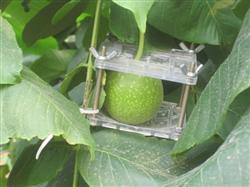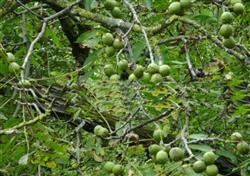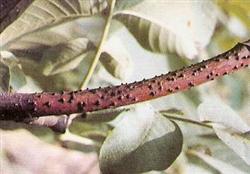How to spray walnut foliar fertilizer

How to spray walnut foliar fertilizer? Please guide foliar spraying is an auxiliary measure of soil fertilization, that is, a certain concentration of fertilizer solution is sprayed directly on the stems and leaves of walnut trees with spraying tools, so as to improve the quality and quantity of fruits. Foliar fertilizer spraying is the use of the upper part of walnut trees, including stems, leaves, pericarp and other organs can directly absorb nutrients, with the advantages of directness and quick effect. Generally, 15-60 minutes after fertilization outside the root, the tree can absorb the fertilizer liquid. Especially in the case of natural disasters or sudden element deficiency, or in order to supplement the elements which are easily fixed by the soil, the loss can be recovered in time by external fertilization. Therefore, extra-root topdressing has the advantages of low cost, simple operation, high fertilizer utilization rate and good effect, which is an economical and effective way of fertilization. Spraying boron at flowering stage can increase the fruit setting rate. Spraying ferrous sulfate from May to June can thicken the leaves and increase photosynthesis. Spraying potassium sulfate from July to August can effectively improve the quality of walnut kernel. The fertilizer type, concentration and spraying time of extra-root topdressing are mainly determined according to soil condition and tree nutrition level. The common principle is that the concentration of walnut can be lower in the early growing period and higher in the later period. In the area of lack of water and fertilizer, the frequency of fertilizer spraying can be more. Fertilizer spraying can generally spray urea, calcium superphosphate, potassium phosphate, copper sulfate, ferrous sulfate and borax and other fertilizers to supplement nitrogen, phosphorus, potassium and other trace elements. Generally speaking, fertilizer spraying should be carried out at 8: 10 a.m. or after 16:00 in the afternoon, but not in rainy or windy weather. If it rains 15 minutes after spraying fertilizer, it is best to apply it again after the weather clears up. Click to get more walnut planting techniques click to get more fruit planting techniques
- Prev

How to control the diseases and insect pests of Carya cathayensis
How to control the diseases and insect pests of hickory? Please guide the prevention and control methods of diseases and insect pests of Carya cathayensis can refer to the following: there are many diseases and insect pests in Carya cathayensis seedlings, the common pests are buds, beetle larvae, ground tiger larvae and so on, the disease is mainly root rot. Control of diseases and insect pests to master "prevention is more important than treatment, prevention is the main".
- Next

What is walnut branch blight?
What is walnut branch blight? How to prevent and cure it? Please advise that walnut branch blight is caused by fungal infection, which mainly harms the branches. It occurs everywhere, the general disease plant rate is 20-30%, the serious disease plant rate is more than 80%, causing a large number of branches to die, directly affecting the tree growth and walnut yield.
Related
- Moge, come on! The staff of the peasant association in the producing area of cantaloupe were frightened when the crowd gathered.
- Causes and Solutions of low Fruit setting rate of Apple
- Symptoms and control measures of passion fruit virus disease
- Fruit growing lesson: how do apple orchards keep high yields?
- Can you build orchards in the mountains? What are the pros and cons?
- How to manage the coloring period of Crisson grape?
- This paper introduces the processing technology of two kinds of fig products.
- How much is a month for retired teachers in rural areas by 2020?
- How can strawberry planting increase sugar content? We should pay attention to management in many aspects.
- What are the cultivation techniques on how to improve the yield of golden fruit?

